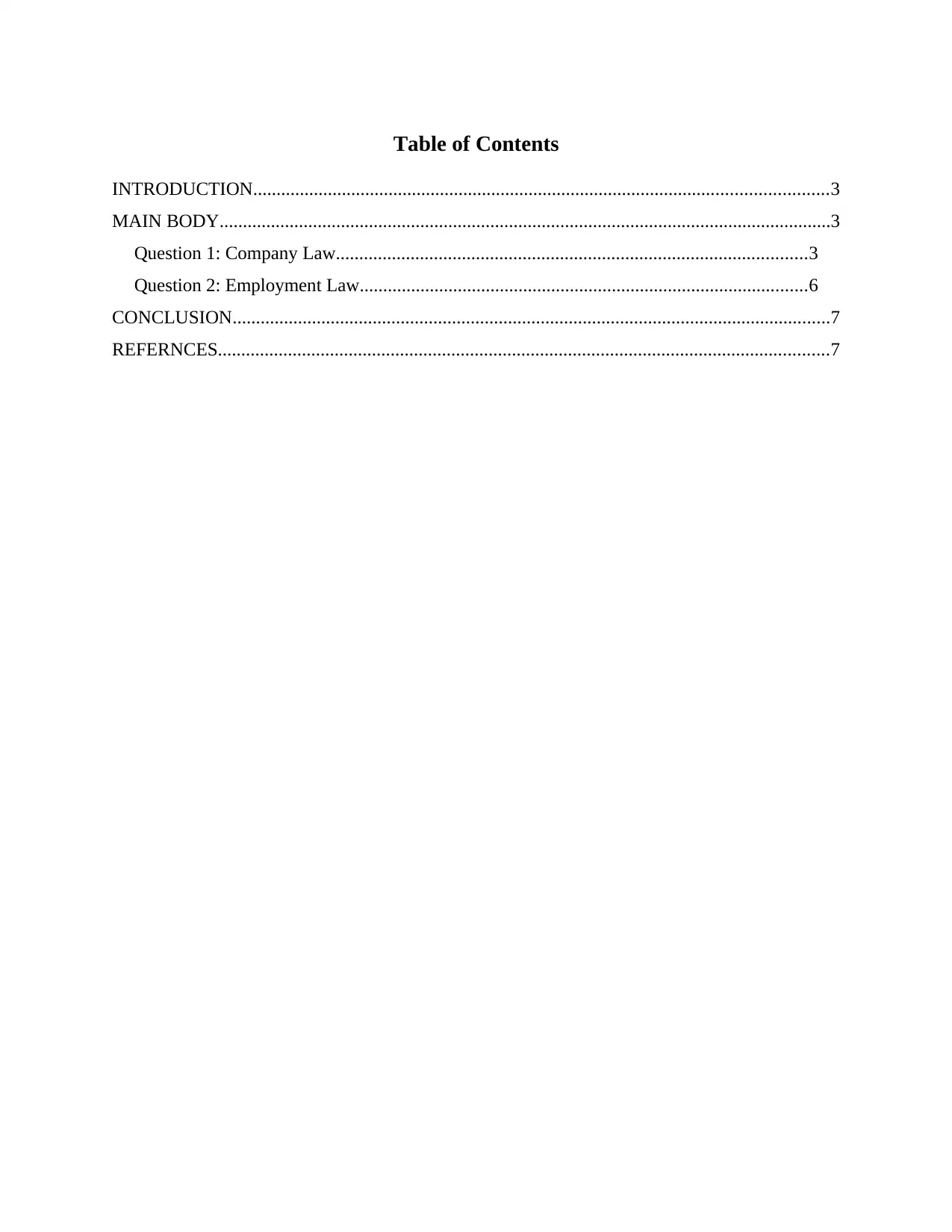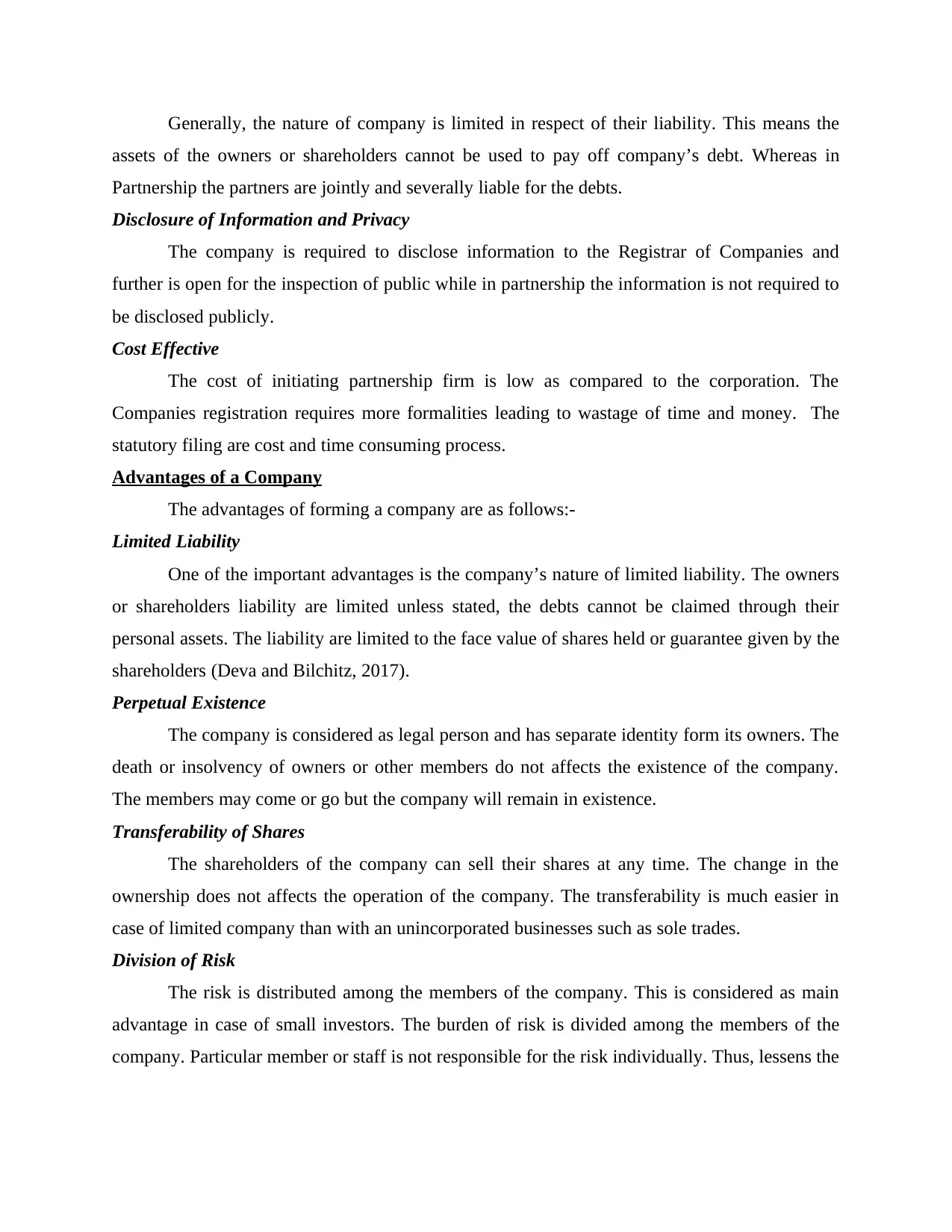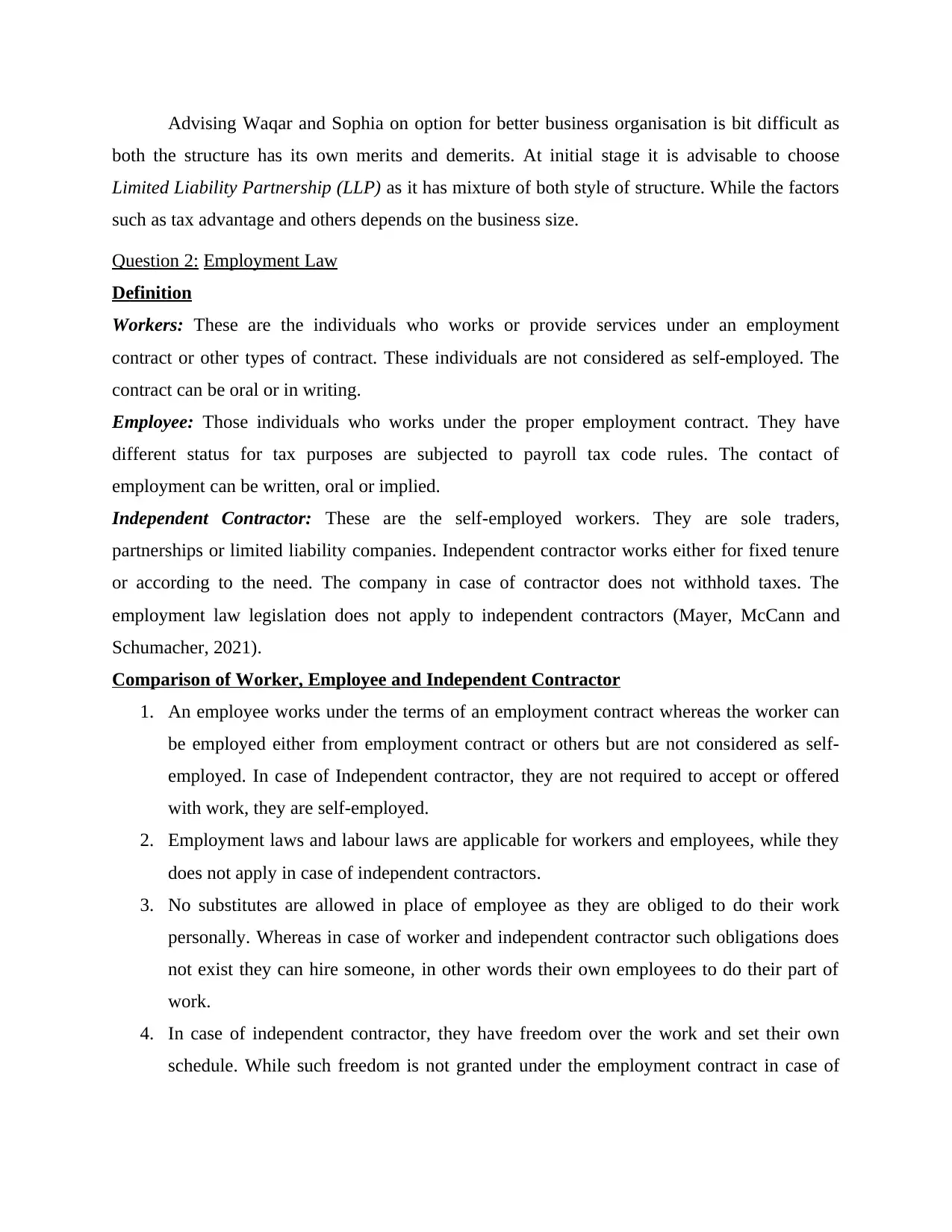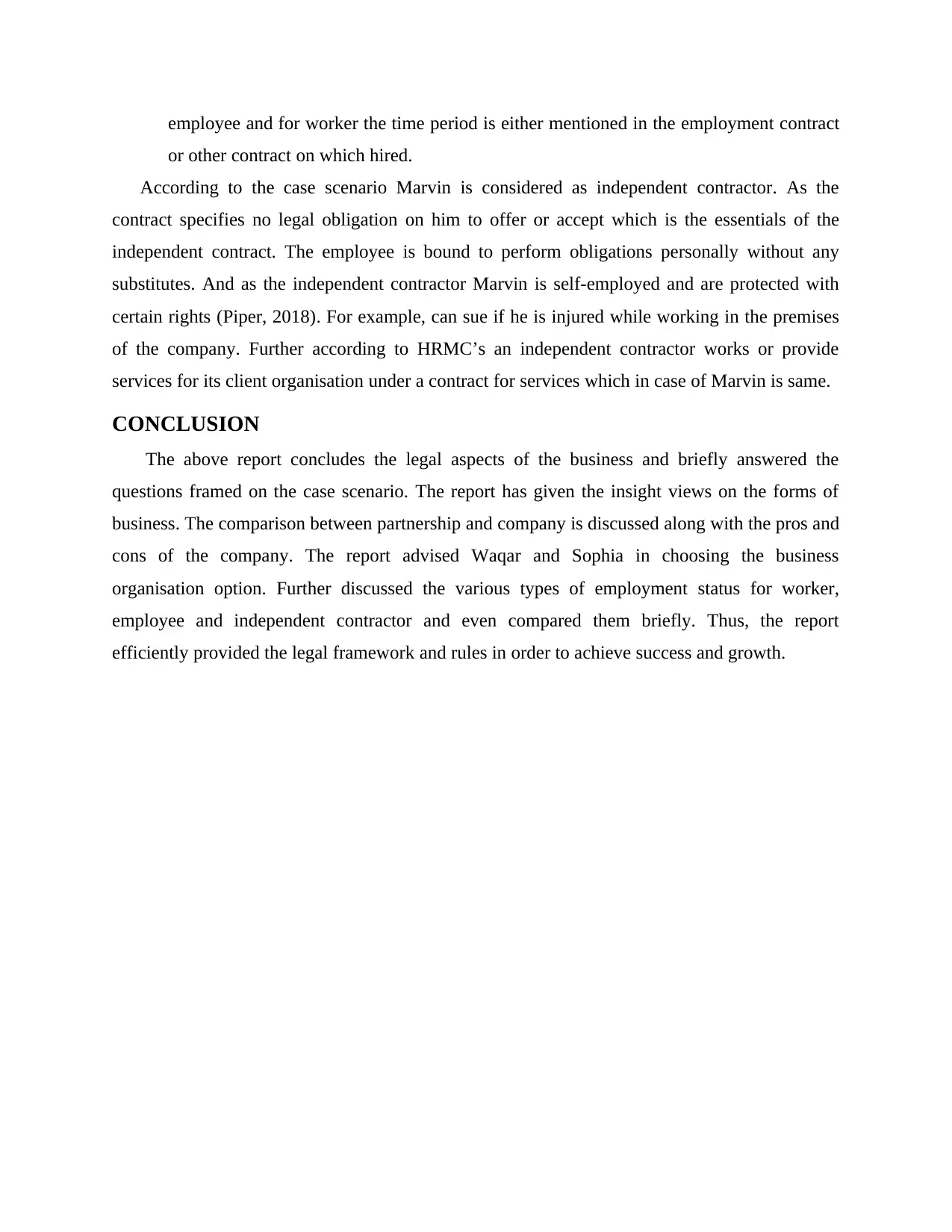Legal Aspects of Business Report: Company, Employment Law Analysis
VerifiedAdded on 2022/12/14
|8
|1899
|462
Report
AI Summary
This report provides a comprehensive analysis of the legal aspects of business, addressing key concepts in company law and employment law. It begins by defining and comparing partnerships and companies, outlining their differences in terms of legal entity, liability, information disclosure, and cost-effectiveness. The report then details the advantages and disadvantages of forming a company, including limited liability, perpetual existence, transferability of shares, division of risk, expansion capabilities, and tax advantages, while also highlighting disadvantages like complex administration and privacy concerns. Furthermore, the report offers advice to Waqar and Sophia on choosing the most suitable business organization. The second part of the report focuses on employment law, defining and comparing workers, employees, and independent contractors. It explains the applicability of employment and labor laws, the obligations of each status, and the level of control they have over their work. Finally, the report concludes by summarizing the legal frameworks discussed and providing a basis for informed decision-making in business operations.

Legal Aspects of
Business
Business
Paraphrase This Document
Need a fresh take? Get an instant paraphrase of this document with our AI Paraphraser

Table of Contents
INTRODUCTION...........................................................................................................................3
MAIN BODY...................................................................................................................................3
Question 1: Company Law.....................................................................................................3
Question 2: Employment Law................................................................................................6
CONCLUSION................................................................................................................................7
REFERNCES...................................................................................................................................7
INTRODUCTION...........................................................................................................................3
MAIN BODY...................................................................................................................................3
Question 1: Company Law.....................................................................................................3
Question 2: Employment Law................................................................................................6
CONCLUSION................................................................................................................................7
REFERNCES...................................................................................................................................7

INTRODUCTION
Legal Aspects is important while initiating a business in order to influence growth and success in
the future. It is vital to compare different possible legal business and choose among them which
suits the entrepreneur. There are three basic forms of legal business which can be chosen: sole
proprietorship, partnership firm and company or corporation. Further United Kingdom regulates
the business under the Companies Act, 2006 and employment relations through Employment
Legislation (Collins, Ewing and McColgan, 2019). The law regulates the business or entity in
accordance with the prevailing law keeping in view the changing needs. The report examines the
questions framed from the case scenario and advising on the legal aspects of the business.
MAIN BODY
Question 1: Company Law
Definition
Partnership: The Partnership firm is a profit making organisation comprises two or more
members. Partnerships are governed in United Kingdom by the Partnership Act, 1890. Under the
partnership firm partners are jointly and severally liable for debts occurring in the business as the
nature of liability is unlimited. Further differs from the Limited Liability Partnership, which is
established under Limited Liability Partnership Act, 2000.
Company: The Company in UK is governed by the Company Act, 2006 which describes as
legal entity formed to operate a business either in commercial or industrial capacity. The
structure of the company differs from sole proprietorship to a corporation, profit making to non-
profit making organisations. The company is considered as separate and distinct from its owner
due to the concept of separate legal entity (Salmon v Salmon & Co. Ltd.).
Comparison of Partnership and Company
The partnership and company both differs and their key differences are discussed below.
Legal Entity
A company adheres the concept of separate legal entity and is known as single legal
person, having own rights and responsibilities. Thus, able to formulate contracts through
directors or other members. Whereas in partnership, the individuals may commit partnership to
any agreement (Das, 2019). Thus, the partners are self-employed and can make decisions.
Liability
Legal Aspects is important while initiating a business in order to influence growth and success in
the future. It is vital to compare different possible legal business and choose among them which
suits the entrepreneur. There are three basic forms of legal business which can be chosen: sole
proprietorship, partnership firm and company or corporation. Further United Kingdom regulates
the business under the Companies Act, 2006 and employment relations through Employment
Legislation (Collins, Ewing and McColgan, 2019). The law regulates the business or entity in
accordance with the prevailing law keeping in view the changing needs. The report examines the
questions framed from the case scenario and advising on the legal aspects of the business.
MAIN BODY
Question 1: Company Law
Definition
Partnership: The Partnership firm is a profit making organisation comprises two or more
members. Partnerships are governed in United Kingdom by the Partnership Act, 1890. Under the
partnership firm partners are jointly and severally liable for debts occurring in the business as the
nature of liability is unlimited. Further differs from the Limited Liability Partnership, which is
established under Limited Liability Partnership Act, 2000.
Company: The Company in UK is governed by the Company Act, 2006 which describes as
legal entity formed to operate a business either in commercial or industrial capacity. The
structure of the company differs from sole proprietorship to a corporation, profit making to non-
profit making organisations. The company is considered as separate and distinct from its owner
due to the concept of separate legal entity (Salmon v Salmon & Co. Ltd.).
Comparison of Partnership and Company
The partnership and company both differs and their key differences are discussed below.
Legal Entity
A company adheres the concept of separate legal entity and is known as single legal
person, having own rights and responsibilities. Thus, able to formulate contracts through
directors or other members. Whereas in partnership, the individuals may commit partnership to
any agreement (Das, 2019). Thus, the partners are self-employed and can make decisions.
Liability
⊘ This is a preview!⊘
Do you want full access?
Subscribe today to unlock all pages.

Trusted by 1+ million students worldwide

Generally, the nature of company is limited in respect of their liability. This means the
assets of the owners or shareholders cannot be used to pay off company’s debt. Whereas in
Partnership the partners are jointly and severally liable for the debts.
Disclosure of Information and Privacy
The company is required to disclose information to the Registrar of Companies and
further is open for the inspection of public while in partnership the information is not required to
be disclosed publicly.
Cost Effective
The cost of initiating partnership firm is low as compared to the corporation. The
Companies registration requires more formalities leading to wastage of time and money. The
statutory filing are cost and time consuming process.
Advantages of a Company
The advantages of forming a company are as follows:-
Limited Liability
One of the important advantages is the company’s nature of limited liability. The owners
or shareholders liability are limited unless stated, the debts cannot be claimed through their
personal assets. The liability are limited to the face value of shares held or guarantee given by the
shareholders (Deva and Bilchitz, 2017).
Perpetual Existence
The company is considered as legal person and has separate identity form its owners. The
death or insolvency of owners or other members do not affects the existence of the company.
The members may come or go but the company will remain in existence.
Transferability of Shares
The shareholders of the company can sell their shares at any time. The change in the
ownership does not affects the operation of the company. The transferability is much easier in
case of limited company than with an unincorporated businesses such as sole trades.
Division of Risk
The risk is distributed among the members of the company. This is considered as main
advantage in case of small investors. The burden of risk is divided among the members of the
company. Particular member or staff is not responsible for the risk individually. Thus, lessens the
assets of the owners or shareholders cannot be used to pay off company’s debt. Whereas in
Partnership the partners are jointly and severally liable for the debts.
Disclosure of Information and Privacy
The company is required to disclose information to the Registrar of Companies and
further is open for the inspection of public while in partnership the information is not required to
be disclosed publicly.
Cost Effective
The cost of initiating partnership firm is low as compared to the corporation. The
Companies registration requires more formalities leading to wastage of time and money. The
statutory filing are cost and time consuming process.
Advantages of a Company
The advantages of forming a company are as follows:-
Limited Liability
One of the important advantages is the company’s nature of limited liability. The owners
or shareholders liability are limited unless stated, the debts cannot be claimed through their
personal assets. The liability are limited to the face value of shares held or guarantee given by the
shareholders (Deva and Bilchitz, 2017).
Perpetual Existence
The company is considered as legal person and has separate identity form its owners. The
death or insolvency of owners or other members do not affects the existence of the company.
The members may come or go but the company will remain in existence.
Transferability of Shares
The shareholders of the company can sell their shares at any time. The change in the
ownership does not affects the operation of the company. The transferability is much easier in
case of limited company than with an unincorporated businesses such as sole trades.
Division of Risk
The risk is distributed among the members of the company. This is considered as main
advantage in case of small investors. The burden of risk is divided among the members of the
company. Particular member or staff is not responsible for the risk individually. Thus, lessens the
Paraphrase This Document
Need a fresh take? Get an instant paraphrase of this document with our AI Paraphraser

burden which is considered as merit as compared to other unincorporated businesses such as sole
traders.
Expansion
The company has no limit in number of shareholders as they normally the company
reserves are used for purpose of expansion through wider capital and skills. Further the
expansion is through issuing of new shares and debentures.
Tax Advantage
The businesses like sole trader or partnerships are liable to pay personal tax on their profits
or in accordance with the share of the profits in case of partnership firms. While the tax for
incorporated business are much lower as limited company pay corporate tax. Profits are
generally extracted from salary and dividend of the company.
Disadvantages of a Company
The disadvantages of forming a company are as follows:-
Complex Administration
As compared to unincorporated business the company has complex administrative
process. The formalities are time and money consuming, further less cost effective. The reporting
requirements are too complex such as filing statement with House of Companies and then to
HMRC (Haddon, 2018).
Funding
Bank provides the fund on basis of the company’s track record. Generally bank offers loan
on personal guarantee form the owners or directors. When company fails to repay loan, the bank
makes it pay the arrears on basis of personal guarantee.
Privacy
The company is required to disclose its information and account for public inspection.
They can also see the dates of filing the accounts, whether any penalty occurred. Whereas the
scenario is not same in unincorporated business.
Failure to perform obligations
The owners or directors of the company are held personally liable for the losses of the
company in case fails to perform their legal obligations. The directors are punished if they fails
to take reasonable steps in preventing illegal actions (Mayer, 2018).
traders.
Expansion
The company has no limit in number of shareholders as they normally the company
reserves are used for purpose of expansion through wider capital and skills. Further the
expansion is through issuing of new shares and debentures.
Tax Advantage
The businesses like sole trader or partnerships are liable to pay personal tax on their profits
or in accordance with the share of the profits in case of partnership firms. While the tax for
incorporated business are much lower as limited company pay corporate tax. Profits are
generally extracted from salary and dividend of the company.
Disadvantages of a Company
The disadvantages of forming a company are as follows:-
Complex Administration
As compared to unincorporated business the company has complex administrative
process. The formalities are time and money consuming, further less cost effective. The reporting
requirements are too complex such as filing statement with House of Companies and then to
HMRC (Haddon, 2018).
Funding
Bank provides the fund on basis of the company’s track record. Generally bank offers loan
on personal guarantee form the owners or directors. When company fails to repay loan, the bank
makes it pay the arrears on basis of personal guarantee.
Privacy
The company is required to disclose its information and account for public inspection.
They can also see the dates of filing the accounts, whether any penalty occurred. Whereas the
scenario is not same in unincorporated business.
Failure to perform obligations
The owners or directors of the company are held personally liable for the losses of the
company in case fails to perform their legal obligations. The directors are punished if they fails
to take reasonable steps in preventing illegal actions (Mayer, 2018).

Advising Waqar and Sophia on option for better business organisation is bit difficult as
both the structure has its own merits and demerits. At initial stage it is advisable to choose
Limited Liability Partnership (LLP) as it has mixture of both style of structure. While the factors
such as tax advantage and others depends on the business size.
Question 2: Employment Law
Definition
Workers: These are the individuals who works or provide services under an employment
contract or other types of contract. These individuals are not considered as self-employed. The
contract can be oral or in writing.
Employee: Those individuals who works under the proper employment contract. They have
different status for tax purposes are subjected to payroll tax code rules. The contact of
employment can be written, oral or implied.
Independent Contractor: These are the self-employed workers. They are sole traders,
partnerships or limited liability companies. Independent contractor works either for fixed tenure
or according to the need. The company in case of contractor does not withhold taxes. The
employment law legislation does not apply to independent contractors (Mayer, McCann and
Schumacher, 2021).
Comparison of Worker, Employee and Independent Contractor
1. An employee works under the terms of an employment contract whereas the worker can
be employed either from employment contract or others but are not considered as self-
employed. In case of Independent contractor, they are not required to accept or offered
with work, they are self-employed.
2. Employment laws and labour laws are applicable for workers and employees, while they
does not apply in case of independent contractors.
3. No substitutes are allowed in place of employee as they are obliged to do their work
personally. Whereas in case of worker and independent contractor such obligations does
not exist they can hire someone, in other words their own employees to do their part of
work.
4. In case of independent contractor, they have freedom over the work and set their own
schedule. While such freedom is not granted under the employment contract in case of
both the structure has its own merits and demerits. At initial stage it is advisable to choose
Limited Liability Partnership (LLP) as it has mixture of both style of structure. While the factors
such as tax advantage and others depends on the business size.
Question 2: Employment Law
Definition
Workers: These are the individuals who works or provide services under an employment
contract or other types of contract. These individuals are not considered as self-employed. The
contract can be oral or in writing.
Employee: Those individuals who works under the proper employment contract. They have
different status for tax purposes are subjected to payroll tax code rules. The contact of
employment can be written, oral or implied.
Independent Contractor: These are the self-employed workers. They are sole traders,
partnerships or limited liability companies. Independent contractor works either for fixed tenure
or according to the need. The company in case of contractor does not withhold taxes. The
employment law legislation does not apply to independent contractors (Mayer, McCann and
Schumacher, 2021).
Comparison of Worker, Employee and Independent Contractor
1. An employee works under the terms of an employment contract whereas the worker can
be employed either from employment contract or others but are not considered as self-
employed. In case of Independent contractor, they are not required to accept or offered
with work, they are self-employed.
2. Employment laws and labour laws are applicable for workers and employees, while they
does not apply in case of independent contractors.
3. No substitutes are allowed in place of employee as they are obliged to do their work
personally. Whereas in case of worker and independent contractor such obligations does
not exist they can hire someone, in other words their own employees to do their part of
work.
4. In case of independent contractor, they have freedom over the work and set their own
schedule. While such freedom is not granted under the employment contract in case of
⊘ This is a preview!⊘
Do you want full access?
Subscribe today to unlock all pages.

Trusted by 1+ million students worldwide

employee and for worker the time period is either mentioned in the employment contract
or other contract on which hired.
According to the case scenario Marvin is considered as independent contractor. As the
contract specifies no legal obligation on him to offer or accept which is the essentials of the
independent contract. The employee is bound to perform obligations personally without any
substitutes. And as the independent contractor Marvin is self-employed and are protected with
certain rights (Piper, 2018). For example, can sue if he is injured while working in the premises
of the company. Further according to HRMC’s an independent contractor works or provide
services for its client organisation under a contract for services which in case of Marvin is same.
CONCLUSION
The above report concludes the legal aspects of the business and briefly answered the
questions framed on the case scenario. The report has given the insight views on the forms of
business. The comparison between partnership and company is discussed along with the pros and
cons of the company. The report advised Waqar and Sophia in choosing the business
organisation option. Further discussed the various types of employment status for worker,
employee and independent contractor and even compared them briefly. Thus, the report
efficiently provided the legal framework and rules in order to achieve success and growth.
or other contract on which hired.
According to the case scenario Marvin is considered as independent contractor. As the
contract specifies no legal obligation on him to offer or accept which is the essentials of the
independent contract. The employee is bound to perform obligations personally without any
substitutes. And as the independent contractor Marvin is self-employed and are protected with
certain rights (Piper, 2018). For example, can sue if he is injured while working in the premises
of the company. Further according to HRMC’s an independent contractor works or provide
services for its client organisation under a contract for services which in case of Marvin is same.
CONCLUSION
The above report concludes the legal aspects of the business and briefly answered the
questions framed on the case scenario. The report has given the insight views on the forms of
business. The comparison between partnership and company is discussed along with the pros and
cons of the company. The report advised Waqar and Sophia in choosing the business
organisation option. Further discussed the various types of employment status for worker,
employee and independent contractor and even compared them briefly. Thus, the report
efficiently provided the legal framework and rules in order to achieve success and growth.
Paraphrase This Document
Need a fresh take? Get an instant paraphrase of this document with our AI Paraphraser

REFERNCES
Books and Journals
Collins, H., Ewing, K. and McColgan, A., 2019. Labour law. Cambridge University Press.
Das, P., 2019. Were the UK Corporate Governance Committees a Success. Available at SSRN
3373173.
Deva, S. and Bilchitz, D. eds., 2017. Building a treaty on business and human rights: context
and contours. Cambridge University Press.
Haddon, J., 2018. The impact of employees’ well-being on performance in the
workplace. Strategic HR Review.
Mayer, C., 2018. Prosperity: better business makes the greater good. Oxford University Press.
Mayer, C., McCann, P. and Schumacher, J., 2021. The structure and relations of banking
systems: the UK experience and the challenges of ‘levelling-up’. Oxford Review of
Economic Policy. 37(1). pp.152-171.
Piper, J., 2018. Updates on tax law and consultations in the UK. Nursing And Residential
Care. 20(2). pp.104-106.
Books and Journals
Collins, H., Ewing, K. and McColgan, A., 2019. Labour law. Cambridge University Press.
Das, P., 2019. Were the UK Corporate Governance Committees a Success. Available at SSRN
3373173.
Deva, S. and Bilchitz, D. eds., 2017. Building a treaty on business and human rights: context
and contours. Cambridge University Press.
Haddon, J., 2018. The impact of employees’ well-being on performance in the
workplace. Strategic HR Review.
Mayer, C., 2018. Prosperity: better business makes the greater good. Oxford University Press.
Mayer, C., McCann, P. and Schumacher, J., 2021. The structure and relations of banking
systems: the UK experience and the challenges of ‘levelling-up’. Oxford Review of
Economic Policy. 37(1). pp.152-171.
Piper, J., 2018. Updates on tax law and consultations in the UK. Nursing And Residential
Care. 20(2). pp.104-106.
1 out of 8
Related Documents
Your All-in-One AI-Powered Toolkit for Academic Success.
+13062052269
info@desklib.com
Available 24*7 on WhatsApp / Email
![[object Object]](/_next/static/media/star-bottom.7253800d.svg)
Unlock your academic potential
Copyright © 2020–2025 A2Z Services. All Rights Reserved. Developed and managed by ZUCOL.





